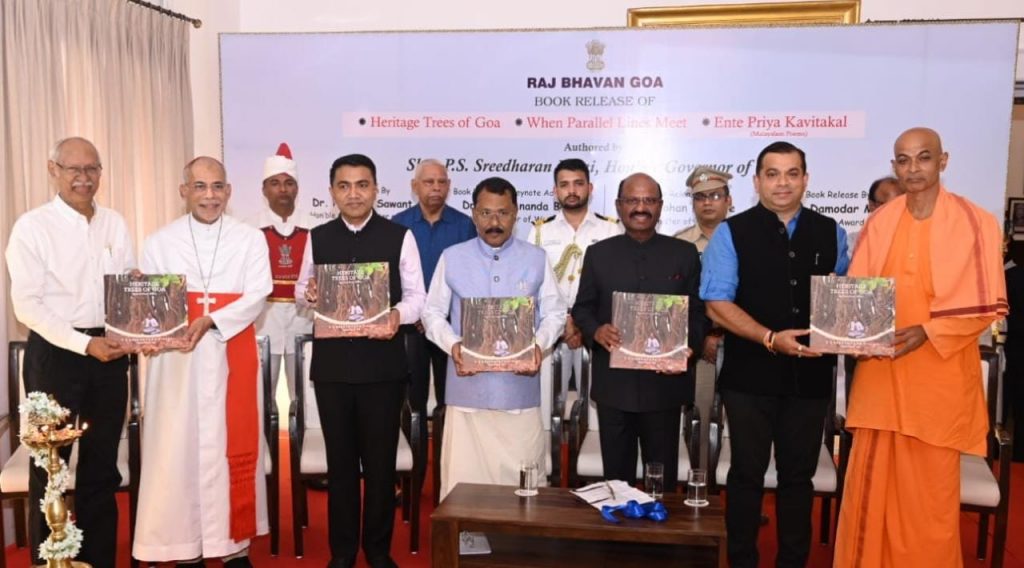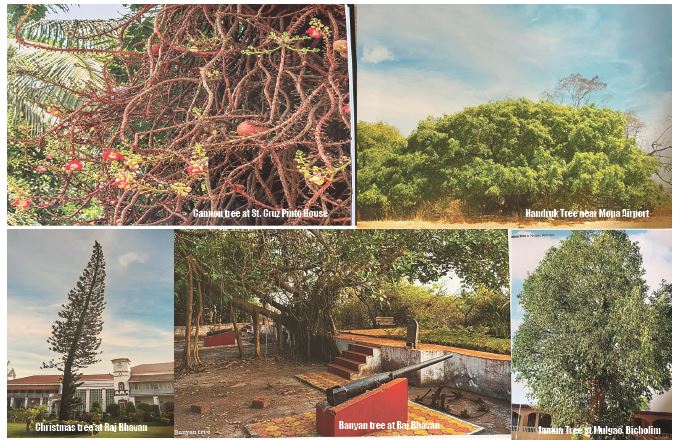Goa is abuzz with excitement as vintage bike and car owners, users, collectors and fans are decking […]

TREES ARE THE ANCIENT GUARDIANS OF INDIA!
Life & Living, Sept 09 - Sept 15 2023 September 8, 2023AT THE RELEASE OF THE `HERITAGE TREES OF GOA’… doing the honors were Goa Chief Minister Dr Pramod Sawant,West Bengal Governor Dr CV Ananda Bose, Tourism Minister Rohan Kaunte, Jnanapeetha winner Damoda Mauzo, Goa Cardinal Felipe Neri Ferrao, Goa Ramakrishna Mission Secretary Swami Maheshatmananda and senior journalist Pachu Menon all of whom got a copy of the book, respectively.
By Tara Narayan
`Heritage Trees of Goa: Saimik Daiz Yatra’ by PS Sreedharan Pillai, Governor of Goa, hardcover, Goa Raj Bhavan Publications, 2023
IT’S a most handsome luxurious coffee table of a book on some famous trees of Goa (and of course India that was and still is evergreen Bharat)! Only a sensitive soul could have thought of it and the current Governor PS Sreedharan Pillai of Goa has a sensitive soul – being a prolific writer and poet in Malayalam he is the author of innumerable books. But it is this compilation of famous trees of Goa he has done Goans a singular service and that is of renewing our love for trees of our land.
For trees are the guardians of a land and they have been the natural preservers of air, earth and water of our otherwise finite planet earth…it takes books like this to make a younger generation take a second look at the trees we’ve worshipped and revered in our ancient culture and right up to our modern, ultra-modern, science and technology-driven times!
Goa can give Governor Pillai a pat on the back for this book to remind Goans that in fact, Goa has trees which can bring tourists of another kind in to just look at the trees, the majestic trees which are still firmly embedded in the soil of Goa, these are the landmark trees which are worshipped and have seen generations come and go and can tell stories of a bygone past if only we gave tune to stop a while to stir up the imagination — looking at them with the inner eye!
It says much for Governor Pillai’s concern that he took time off from his busy administrative duties to make these tree pilgrimages or “Saimik Daiz Yatra” (Natural Heritage Yatra) to put together a grandstanding picturesque book of this kind for posterity. We now have a reference point of where to find a particular much revered tree, or just inspirational tree rooted in the Goan countryside for ages.
In his Exordium to the book Governor Pillai quotes from the Rig-Veda and Atharvaveda, “Heaven is my father, brother atmosphere is my navel, and the great earth is my mother.’ It means heaven and earth are our parents. Say it is ancient wisdom enshrined in the living testimony of the trees of our country. Others who have welcomed the book are Chief Minister of Goa Dr Pramod Sawant who in his Foreword points out truly, “In Goa trees are believed to be the dwelling place of gods and goddesses or holy spirits and even evil spirits…”
The book showcases 31 unique or landmark trees of Goa which are all revered as over a hundred years plus, plus, many being located near temples or churches. Special Officer to Governor R Mihir Vardhan has written the Preface for the book and Aashirvad for this book comes from Shreemad Vidyadheesh Teerth Shripad Vader (Swamiji of Gokarn Partagali Jeevottam Math, Canacona).
So here in artistic pictorial and textural sweeps are some of the famous trees of Goa: the grand banyan, “vat vruksha” or Ficus Bengalensis ) sited at the Partagal Math and where so many pay homage; there’s the shidam or zarmal (Tetrameles Nudiflora) tree at Shreesthal Canacona; the peepal (Ficyus Religiosa) at Bhumika Temple Poirem, Sattari; satwin tree at Thane, Sattari; jambhul or jamun tree at Thane, Sattari; ghosting tree at Bhuipal, Sattari; and a kindal tree also at Bhuipal, Sattari.
And the baobab (Quepem town down south Goa), the maddi in Margao, mango tree of Malikarjun temple in Gaondongri in Canacona (do you know one tradition has it that a bridal couple may embrace the auspicious mango tree before marriage?), the nandruk tree at Bicholim, the cannonball tree at Pinto House in Santqa Cruz (a most interesting tree hailing from South America originally); bakul tree at the shrine of Siddhdeshwar in Bicholim; the arjun tree, Bicholim; kazro tree at Narve at Masandevi temple; ever heard of huro tree (Falconeria Insignis Royle, also called tiger’s milk spruce tree) at Pirna…kosamb, jackfruit, more banyan trees – the grandest of all trees perhaps for it is a veritable joint family of a tree offering shelter to all creatures of the wild.

There are several repeats of banyans, peepals and baobab (also called gorak chinch), mangos, kazros, jambhuls; and there’s special chapter on the heritage trees standing strong and tall at the Goa Raj Bhavan grounds which add up to something like 88 acres of land fronting the Arabian sea. Here are the familiar trees of swaying Christmas pine trees, mango, African tulip , banyan, matti (also crocodile tree, the state tree of Goa) and of course, magnificent classical banyan. Like it or not a new Raj Bhavan is coming up and one may only pray it will not be a killjoy to the old 16th century structure of colonial Portuguese vintage times! The question arises, do buildings grace trees or trees grace buildings? The trees were here first and command more respect surely?
“Heritage Trees of Goa” – courtesy Governor of Goa PS Sreedharan Pillai travels to pay homage to trees in Goa – is very definitely a collector’s book, especially if you love, respect and worship trees, as you should every waking moment of your life on the good earth we call Mother Earth for a myriad sane reasons!
Excerpted from `Heritage Trees of Goa’ by PS Sreedharan Pillai, Governor of Goa….
“IN Bharath, our forefathers believed that if we eliminate any species, there will be an adverse effect on nature and ultimately man himself would face trouble. Normally, we never like to use the phrase exploit nature.’ While depending on nature our approach is to cater to the need and not to satisfy the greed. Most of the Western countries followed thehuman-centric’ approach towards nature and ecology. Under such a philosophy everything in and around us are for human beings and other creatures have no role to play in it. But in Bharath, we have followed eco-centric’ approach in which all creatures are considered to be bestowed by God and we have to follow a cordial relation with them.
Feeling of oneness with nature was developed in India from olden days. Our ancient civilisation provided traditional knowledge, attachment towards trees, pooja of trees, worshipping nature, etc., as part of our life. Our knowledge system focused on the liberation of human beings from the sheer darkness of unawareness. Preservation of land, water, air, hills, forests, rivers, oceans, plants, trees, herbs, shrubs , all life forms, and even planets was the central issue in the ancient Indian system of social life. Our objectives such as clean country, green forests, clear rivers, pure air, etc, are all parts of thiseco-centric’ concept.
Moreover, the Ajivika philosopher (Indian school of thought founded in 5th century BC) mentioned plants as capable of feeling the touch of others. Plant biologist Simcha Lev-Yadun, from the University of Haifa (Israel), said that plants can also see, hear, smell and taste, and of course respond to touch. In 10th Century, Buddhist monks also proved this theory as true. But unfortunately, European-American scientists turned a blind eye to the research and findings of reputed Indian scientist Shri J. C. Bose. Researchers have found plants to possess many sophisticated and surprising abilities. Plants can sense and react to more aspects of their environments than we can, and they maintain bustling social lives by communicating with each other above and below the ground. They also interact with other species. Famous playwright George Bernard Shaw, who was a vegetarian is said to have cried, during one of the J.C. Bose experiments using crescograph (crescograph is a device for measuring growth in plant) showing the screams of agony of a plant. Plants playing on consciousness, music of plants, plant waves, etc, are yet to undergo more studies. Our ancient texts were vocal on this subject. Ancient forests and trees have out lasted the challenges of crisis faced by the world ecosystem . Now, everybody is pleading for the protection of nature.”















